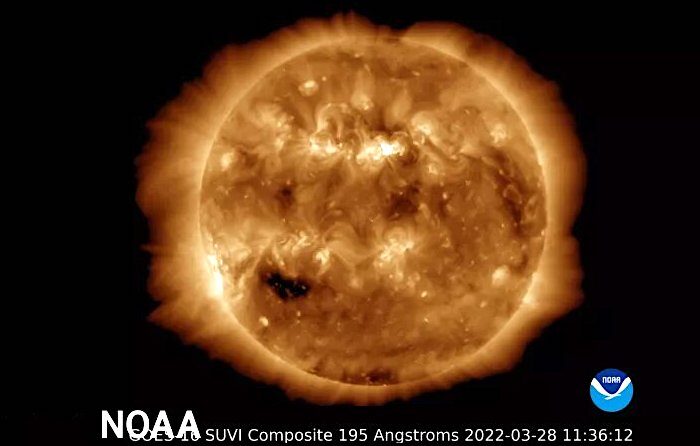
The U.S. National Oceanic and Atmospheric Administration (NOAA) warned that two coronal mass ejections (CMEs), spat out from the overactive sunspot AR2975, on Monday (March 28), are heading toward our planet and might trigger a geomagnetic storm rated as G3 on NOAA's five-point scale.
CMEs are huge expulsions of magnetized particles released from the sun's upper atmosphere, the corona. If those charged clouds hit Earth, they can wreak havoc with the planet's magnetic field, causing disruptions to satellites, electric grids and telecommunication networks.
A G3-level solar storm, NOAA said in a statement, is unlikely to have serious impacts on infrastructure. However, it might trigger stunning aurora displays that could be visible from locations more distant from the poles than regions where auroras are usually seen.
"Auroras for this storm may be visible, if the weather conditions are favorable, as far south as Pennsylvania to Iowa to Oregon and points north," NOAA said in the statement.
Since Earth's magnetic field is the weakest above the poles, solar particles penetrate much deeper into the planet's atmosphere in those regions. The interaction between the charged solar particles and particles in Earth's atmosphere then triggers the spectacular polar light displays. During powerful solar storms, these areas where auroras occur, also known as auroral ovals, expand farther away from the poles.
The U.K.'s national weather forecaster Met Office said in a statement that auroras could be visible from Scotland and Northern Ireland on Thursday (March 31). In the Southern Hemisphere, the aurora oval could expand up to 55 degrees latitude, just south of New Zealand and the southern tip of South America.
NOAA has issued a Geomagnetic Storm Watch through Friday (April 1). A minor (G1) alert is in place for Wednesday (March 30), which will increase to moderate (G2) as the storm arrives.
The Met Office expects additional moderate-class solar flares could occur in the upcoming days.
The solar storm and associated phenomena are tied to the sun's currently increasing activity as part of what scientists call solar cycle 25. The sun's activity fluctuates on an 11-year cycle, which had been at its minimum level of activity in the past years. Scientists predict that the solar cycle will hit its maximum in 2025; sunspots, CMEs and solar storms are likely to continue increasing in frequency throughout the coming years.




It blasted out yet another impressive M-class flare at 18:35 on the 31st of March, almost making X-class at M9.6 and will give Earth a glancing blow as it blasts by creating yet more impressive auroras at low latitudes.
I doubt we're out of the woods with this feature, as it will become increasingly more active as it departs the Earth facing side and crosses the limb.
There is however a beast heading in our direction, AR2978 has Earth written all over it.